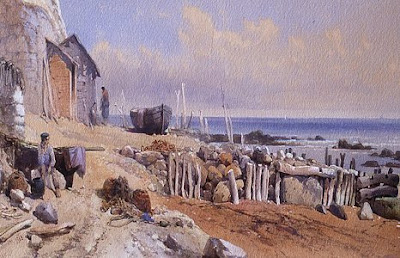Julian Siddle, BBC News 29 Dec 08;
Nineteenth Century artwork is a useful tool for studying coastal erosion, according to a retired coastal engineer.
Robin McInnes assessed the accuracy of geological and topological features in more than 400 paintings of the Isle of Wight and Hampshire coastline. Dr McInnes said such old masters gave engineers the chance to see coastal features before they were changed by industrial development.
Dr McInnes said such old masters gave engineers the chance to see coastal features before they were changed by industrial development.
He was standing in London's Tate Gallery, admiring a painting entitled Pegwell Bay, Kent - a recollection of October 5th 1858 by Pre-Raphaelite artist William Dyce, when the thought struck him that the detailed accurate depiction of groynes and foreshore, despite being painted 150 years ago, might be of use in his work as a coastal engineer.
Over the years, Dr McInnes had amassed quite a collection of paintings, prints and etchings depicting the coastlines of Hampshire and the Isle of Wight, where he ran the island's coastline management strategy.
Combining his interests in paintings of the local environment, geology and coastal erosion, he looked at hundreds of artworks and came up with a method to assess their value as indicators of coastal change - especially erosion.
"From the late 18th Century, Europe was cut off by the Napoleonic wars, this resulted in travellers and artists paying greater attention to the picturesque landscapes of the British Isles," said Dr McInnes.
Artists such as William Turner visited the Hampshire coast and produced panoramic paintings in aquatint and water colour. Dr McInnes began to examine images from the 1770s to the 1920s. From more than 400 paintings, prints and illustrations he drew up a scale to asses how useful such artworks were as coastal engineering tools.
Dr McInnes began to examine images from the 1770s to the 1920s. From more than 400 paintings, prints and illustrations he drew up a scale to asses how useful such artworks were as coastal engineering tools.
"The ranking system is based on four or five factors, it is a qualitative assessment," he said.
"I looked at issues such as the material and the nature of the media, oil paintings versus prints; generally, water colour allowed the most accurate depiction.
"The next question was what do they actually show, do they provide understanding of the geology or beach levels? I gave each a score for that.
"Also to time periods, from a coastal engineers point of view, the most relevant period is when rapid coastal development took place."
Dr McInnes said the Victorian era saw a dramatic change in the coastline as towns, such as Portsmouth, grew with the opening up of railway links.
He also gave marks for the accuracy of the artistic style, and whether the painting showed the topography.
"In Italian landscape style accuracy was not the prime consideration, (whereas) traditional Victorian coastal painting was the most accurate as the idea was to provide an exact image to take home.
"Followers of the pre-Raphaelites captured in precise detail this period, it coincided with an interest in geology and natural sciences. "
He added that the paintings of the period were not just a tool for categorising physical change, but also environmental and developmental issues.
"Many artists returned to the same spot to capture the same scenes over a period of years.
"The study shows how Victorian development has radically changed the coastline; it's nice to strip it back because it helps you understand what might be the underlying problems of erosion and instability.
"Natural processes in the past are largely masked by coastal development," Dr Innes explained.
"Looking back 150 years, it's easier to understand the geography and topography when you don't have this coastal development covering the slopes."
The study - carried out with help from Portsmouth University, the Crown Estate and the National Maritime Museum - has been well received by organisations concerned with coastal erosion.
Dr McInnes recently presented his findings at a coastal engineering conference in Venice, where he learned of similar research that used Caravaggio's paintings to asses historic water levels in the sinking Italian city.
"A lot of people think it can be applied to other parts of the coast that are well illustrated," he says.
The study could be extended, he suggested, to cover areas of south-east England where the erosion of soft rocks, combined with human development, has led to dramatic coastal change.
Artistic clues to coastal change
posted by
Ria Tan
at
12/30/2008 08:40:00 AM
![]()
labels global, marine, rising-seas, shores




